John Best has studied every stained-glass window made by prolific late-19th-century designer Louis C. Tiffany. But one forever changed his outlook: Mermaid With Goldfish. The design is based on the natural lines that Tiffany saw in the raw pane of glass. The only staining he added was in the mermaid’s face and outline. She floats upwards, her hair streaming towards the sky.
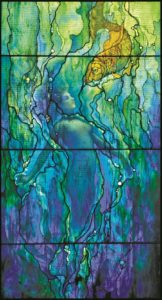
“I decided to start looking carefully, hunting down pieces of glass that had color and movement that would interest me,” says Best from his Wellfleet studio. “I’m a glassaholic.”
From there, Best developed the confidence to work with single sheets of glass, rather than splicing them together. He sources them from glassmakers such as Bullseye Glass Co., who set aside sheets that have emerged from the kiln looking especially distinct.
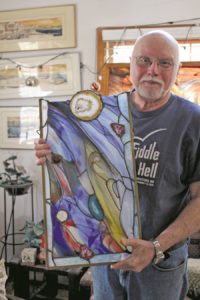
Best carefully studies the flowing patterns in the glass using a lightbox. He then traces the shapes with magic marker or Wite-Out before cutting the glass with a handheld tool. Next, he fills in the cuts with solder — a metal alloy made from tin and lead — which he melts with a hot iron.
Glass isn’t the only raw material Best works with. He sometimes solders shells and stones between the panes. The swirling centers of geodes complement the colored glass patterns.
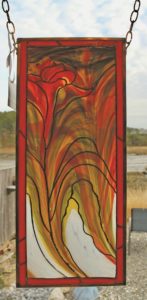
The influence of Mermaid with Goldfish on Best’s work can be seen especially in Daylily, currently on display at Wellfleet’s Left Bank Gallery. It’s unlike Best’s other stained-glass works, which are mostly abstract.
“My art ability outside of color is drawing stick figures,” he admits. But when Best first laid out the glass sheet for Daylily, with its swooping streaks of red and green — so saturated they are almost opaque — the lily bloom jumped out at him.
Even at this stage of his career, Best’s “color sense” surprises him. Years before he started working with glass, Best was a classically trained violinist. “Growing up, I avoided art at all costs because it was not music,” he says. He was encouraged to take up the new discipline by his wife, Elizabeth, a prominent jeweler.
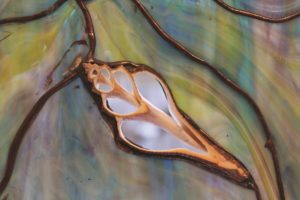
The two met when John started teaching music in the same New Jersey school district where Elizabeth taught art. They soon learned that they both grew up in Bergen County, N.J. and even attended the same college, William Paterson University, though they never crossed paths.
The Bests visited friends in Wellfleet for the first time around 1977. They immediately fell in love with the town and its history. After building a house here in 1996, for some years splitting their time between West Milford, N.J. and Wellfleet, they moved in full-time in 2013.
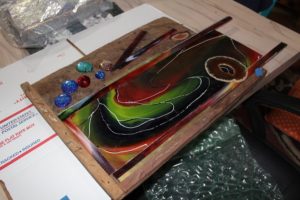
Today, the couple operate jointly out of Best Studios in the basement of their home. “We’ve worked together as long as we’ve known each other,” says Best. He lends Elizabeth scraps of glass to use in her sterling silver jewelry. Elizabeth, also a graphic designer, makes album covers for Best’s band, Black Whydah, which he founded with Jean Sagara in 2007.
When Best started spending more time on Cape after retiring in 2002, he departed from his classical training and learned to fiddle. He jokes that “you can’t throw a rock in Wellfleet without hitting at least five Irish fiddlers.” When asked to describe Black Whydah’s music, Best says, “It’s Irish, it’s old time, it’s original.” As for the instrumentation, “If it’s got strings, it’s on there.”

Best’s creative processes for glass and music aren’t entirely distinct. Often, if he’s frustrated with a glass project, he’ll walk away and pick up an instrument. “It has balanced out my artwork,” he says. He interprets the intricacies of a sheet of glass the way one would a sheet of music. This approach sets Best apart: “I see people’s work and I see great construction, but no love of the glass.”
Best doesn’t go a day without practicing his multiple creative pursuits. He plays at least four different instruments and has released 21 albums. He’s also published five books, including some fiction, and doesn’t plan on slowing down anytime soon. “We’re in our 70s,” he says. “If we stop, it’s all over with.”



